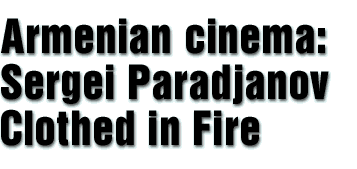|
 |
||
|
You are fire... you are clothed in fire. You are fire... you are clothed in black. The Colour of Pomegranates |
A goddess in gold and brocaded emerald leaves with a head-dress of foliage and white roses, a pantomime harlequin with devil's horns, a feathered crown studded with cameos, a nun in white lace and red lace screens, a scarlet tunic clasped by gilded shells, veiled huntresses with silver parasols, a bright angel with golden wings... These are some of the creations of Sergei Paradjanov, whose films contain not just images but visions. Paradjanov's inventive genius extended to every aspect of his films, not least their dazzling costumes. In his hands a carpet is conjured into a sacred robe, flowers are woven into tunics, gloves and fans become head-dresses where birds and butterflies nest with jewels. Some of these were seen for the first time in London earlier this year at an exhibition at the Judith Clark Costume Gallery, while another at Leighton House displayed his collage creations.
Paradjanov was born Sarkis Paradjanian to Armenian parents in Tbilisi, Georgia in 1924 and studied film under the great Soviet director Alexander Dovzhenko. The costumes he designed himself for his films are the most original and colourful in cinema, surpassing the chromatic delirium of Ivan the Terrible and the exotic treasures of Pasolini's Medea and A Thousand and One Nights, all of them avowed influences on his work. From the beginning of his career, Paradjanov was able to express this decorative impulse even within the constraints of the socialist realism which were imposed upon him, generating in his 1958 collective farming musical The First Lad stupefying levels of kitsch even by the standards of the genre, with smiling shopkeepers hurling bolts of bright cloth across the screen and luridly attired accordion playing tractorists pursuing maidens with flowers blazing from their coiffure, smocks rioting with embroidery, against the ennobling backdrop of the electrification of the Ukrainian sunflower fields.
Paradjanov's final film made in the Ukraine, Shadows of our Forgotten Ancestors, 1964, is as unlike any other film in existence as it is his own formally unique later works, vibrantly kinetic and full of seemingly impossible optical swings and vertices, a magical tale of tragedy and eroticism in a primitive community in the Carpathian mountains where scarlet horses tear across the sky and ghosts wander in silver forests, resembling, if anything, a Chagall painting brought to life. Folkloric costume played a crucial part in the creation of this vision, Paradjanov amassing a spectacular collection of antique dress and folk jewellery to clothe his cast, much of it priceless heirlooms borrowed from local families, some of which, it has been accused, was never returned.
His 1967 masterpiece The Colour of Pomegranates is a bio-pic of the Armenian troubadour Sayat Nova who lived in Georgia in the 18th century, told in a series of static tableaux, like a succession of Byzantine icons, tarot cards, Persian enamels or still lives with angels. Shuffled at the time by the Soviet avant-garde veteran Sergei Yutkevich, these images have only recently been rearranged according to Paradjanov's original scenario. Paradjanov himself called it a "Persian jewellery case", and it is certainly one of the cinema's most remarkable achievements of the synthesis of its collaborative elements. Even those defeated by the film's austerely adorable rejection of conventional narrative dynamics concede the stunning success of Paradjanov's costumes...
James Norton
Full article published in Filmwaves - Issue 10, Winter 2000. Subscribe now!
